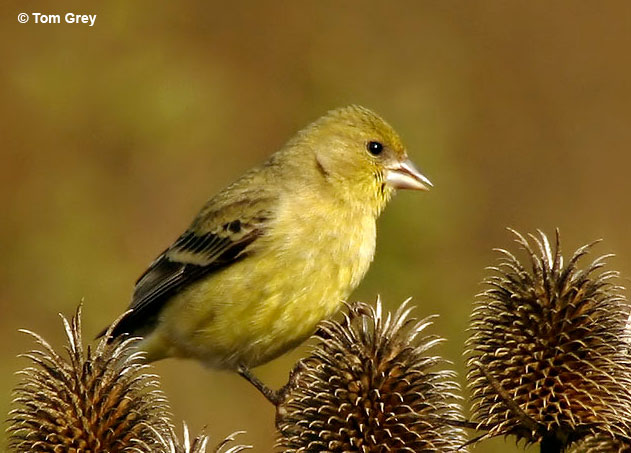The Lesser Goldfinch (Spinus psaltria) is a small songbird with vibrant black-and-yellow plumage. It is an adaptable species with sweet warbling melodies. However, it is important to keep in mind that males have two color morphs. Let’s take a look at what they can look like and how to identify them.
On this page
Identification
Lesser Goldfinches are small birds, measuring about 3.5 to 4.7 inches long with a wingspan of 5.9 to 7.9 inches. They have a compact and sparrow-like body with a short, conical bill, notched tail, and pointed wings.
Male
Male Lesser Goldfinches have two forms depending on their location but can overall be described as having contrasting black-and-yellow plumage. The first type generally lives west of the Rocky Mountains.
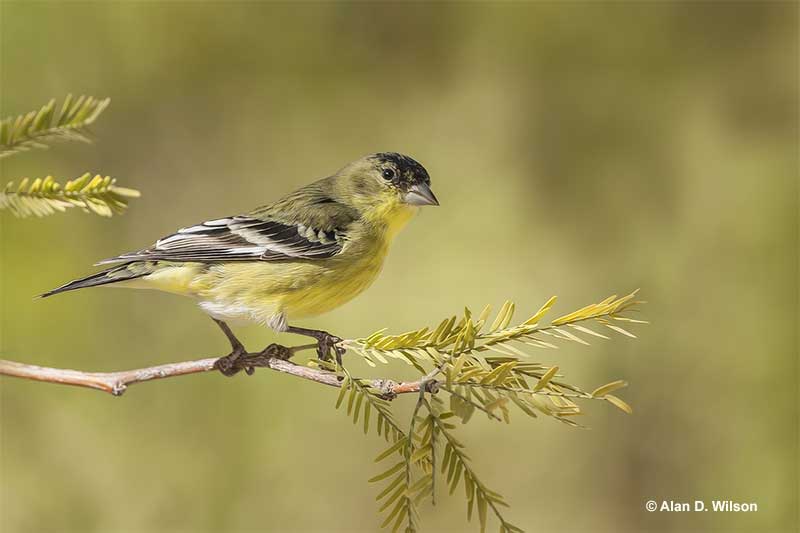
They have a yellow underside, black cap, and dull green backs. Their wings and tails are dark with pale wingbars. You can also see white patches on their wings when they’re flying. The second type can be found across the eastern part of their range. They have black glossy uppersides, yellow undersides, and white patches on their wings.
Female
Female Lesser Goldfinches have a more subdued appearance compared to the males. Their upperparts are olive-green, and the yellow on their underparts is duller and paler than in males. They have black wings with two pale wingbars and white patches on their wings.
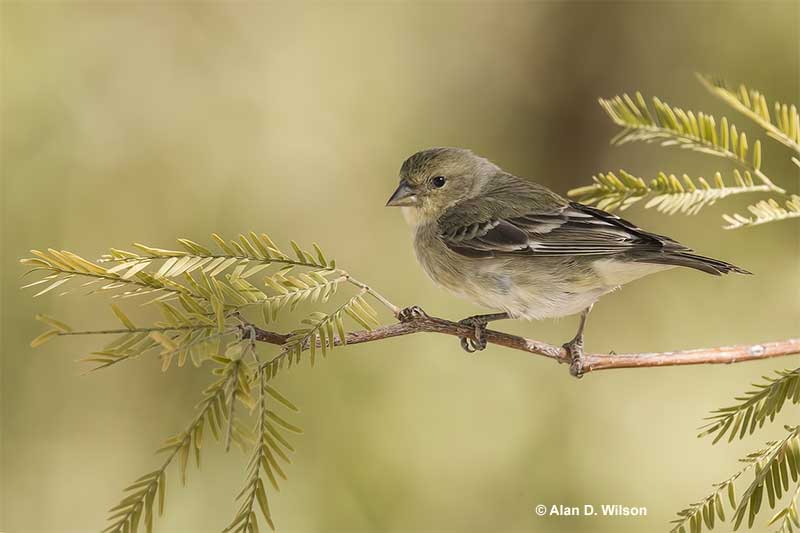
Juvenile Lesser Goldfinches look similar to females. However, juvenile black-backed morphs resemble adult green-backed males.
Vocalizations
The song of the Lesser Goldfinch is a series of musical notes, often described as a lively and twittering warble. It is a bright and cheerful sound, and males may sing from elevated perches to establish territory and attract mates during the breeding season.
When in flight, Lesser Goldfinches may emit a distinctive chig-chig-chig call, which can help identify them as they move through the air. During courtship, males give loud, drawn-out tee-yer calls.
Food
Lesser Goldfinches have a primarily granivorous diet, meaning they predominantly feed on seeds. They are especially fond of seeds from plants such as thistles, sunflowers, dandelions, and other composite flowers.
The birds are equipped with specialized bills that allow them to efficiently extract the seed heads from various plants.
They also eat buds and flowers from trees such as alders, cottonwoods, willows, oaks, and sycamores. On occasion, they may also consume small fruits.
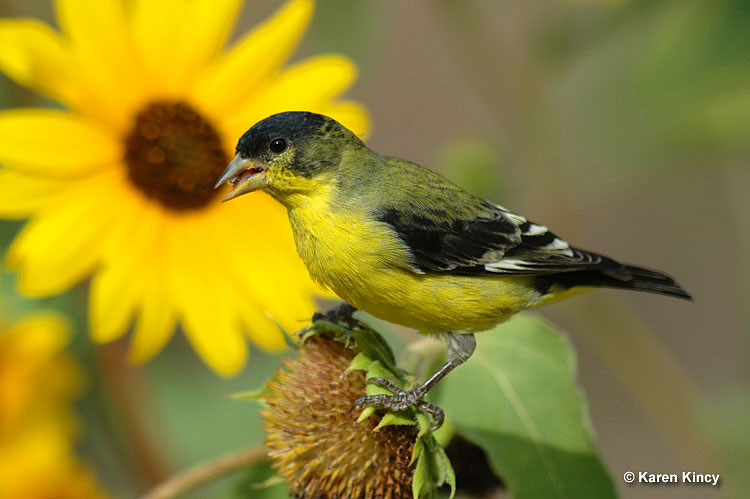
While plant matter is the primary food source, Lesser Goldfinches also include insects in their diet, particularly during the breeding season. Insects provide additional protein and nutrients, crucial for raising healthy chicks. The birds may catch insects in flight or glean them from vegetation.
Their foraging methods involve actively searching for food among vegetation, especially on the tops of plants and trees. You may see them hanging upside down from stems to reach seeds.
Nesting and Eggs
Lesser Goldfinches are seasonally monogamous, meaning that they pair up for one breeding season and then find a new partner for the next. When males arrive on the breeding grounds, they establish and defend a territory by singing from an elevated perch.
They also call from their perch to attract potential mates. When a female enters their territory, the male will chase her and eventually stop on the same perch, stretch their necks towards each other, and call.
Lesser Goldfinches nest in shaded or concealed vertical branch forks 5-30, usually 4-8 feet above the ground. They prefer to nest along the rivers in cottonwoods and willows. The female does most of the building. The open cup measures around 3 inches across and is woven of various plant materials such as leaves, bark, and grasses and lined with softer materials such as plant down, feathers, and hair.
They generally have one to two broods per year with 3-6, mostly 4-5 eggs in a clutch. Lesser Goldfinch eggs are pale bluish-white and measure 0.6 inches long and 0.4-0.5 inches wide. The female incubates the eggs for 12-13 days while the male provides her with food. After the eggs hatch, both parents take care of their offspring. The young leave the nest at 11-15 days old and gain independence a few weeks after that.
Current Situation
Lesser Goldfinches range throughout most of the western United States, Central America, and parts of northern South America. They are resident throughout most of their range but migrate southward from the northern parts of the United States in the winter.
The green-backed subspecies live west of the Rockies as far south as northern Mexico, whereas the black-backed subspecies can be found east of the Rockies and in Central and South America.
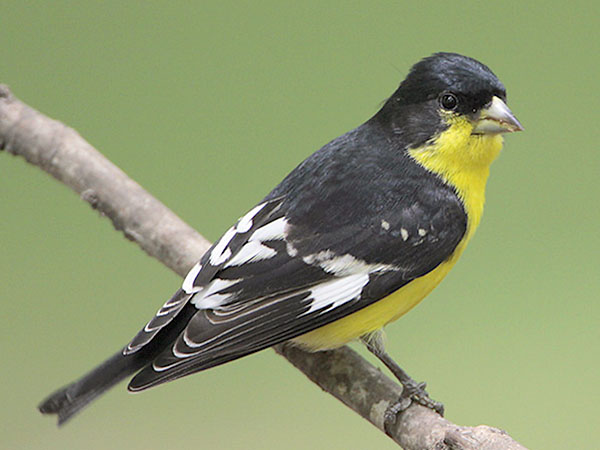
Texas birds have a black back. Photograph © Greg Lavaty.
Lesser Goldfinch habitat preferences vary slightly depending on factors such as geographical location and season, but they are mostly found in open brushy or semi-open areas. This includes open woods, gardens, thickets, weedy fields, woodland edges, urban and suburban areas, riparian habitats, and open deserts.
The Lesser Goldfinch is listed as of least concern on the IUCN Red List. Their population appears stable or slightly decreasing, but it is not very worrisome since this species mostly benefits from human expansion.
Facts
- The Lesser Goldfinch has five recognized subspecies with variable amounts of black and green on the backs and heads of males. Two of them – the green-backed and the black-backed – can be met in the United States.
- The molt of Lesser Goldfinches occurs in stages. They replace some amount of their feathers before breeding and some more after the breeding season. This staggered molting process helps maintain their ability to fly.
- Lesser Goldfinches live for around 3-6 years in the wild. The oldest wild Lesser Goldfinch on record made it to 7 years.
Similar Species
Several species share similarities with the Lesser Goldfinch in terms of size, shape, coloration, and range. Here are some birds that may be difficult to differentiate from this species and ways to tell them apart.
American Goldfinch

American Goldfinches range across most of North America with their wintering range extending into Mexico. Breeding males are vibrant yellow with a black forehead and black wings with fine white markings.
Nonbreeding males are pale tan with pale dirty yellow heads, black wings with two pale wingbars, and black-and-white tails. Breeding females are pale yellow underneath, have yellowish-olive heads and backs, and black wings with white markings.
Males of the species can be distinguished by their backs and bills. Breeding male American Goldfinches have a bright yellow back and a black forehead, whereas male Lesser Goldfinches have either a dull green back and a dark cap or solid black uppersides. Female American Goldfinches have whitish rumps, whereas female Lesser Goldfinches do not.
Evening Grosbeak
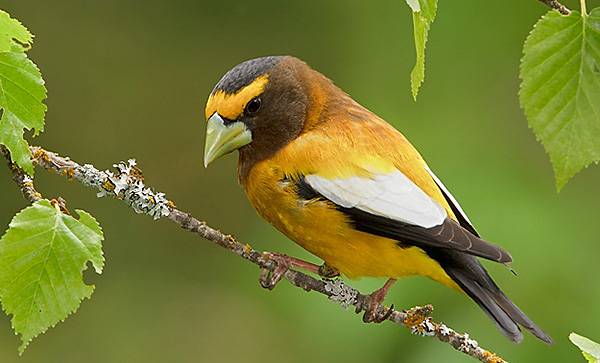
Photograph © Glenn Bartley.
Evening Grosbeaks range throughout most of North America. Males are yellow below, have yellow shoulders, dark backs, vibrant yellow stripe over their eyes, a black cap, and white-and-black wings. Females are mostly gray with greenish and yellowish hues here and there and black-and-white wings. Males have huge conical pale yellow bills and females have greenish bills.
Evening Grosbeaks are larger than Lesser Goldfinches and have thicker bills. Lesser Goldfinches lack the big white patch on their wings that male Evening Grosbeaks have and they don’t have yellow eyebrows either. Female Lesser Goldfinches are gray instead of olive and dull yellow and have smaller and less colorful bills.
Pine Siskin
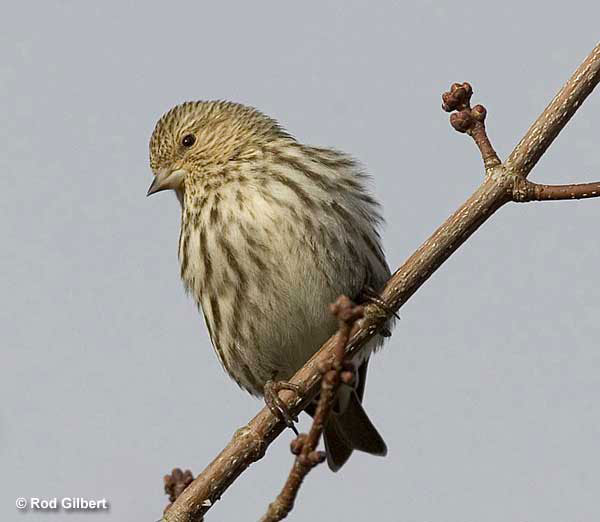
Pine Siskins range throughout most of North America and Central America. Adult birds are brown overall with pale undersides, darker streaking, and yellow on their wings and tails. There’s also a green morph, which has more yellow and/or greenish tones to their whole plumage.
You may confuse Pine Siskins for female or male green-backed Lesser Goldfinches. However, Pine Siskins are heavily streaked overall whereas Lesser Goldfinches are uniformly colored.
Frequently Asked Questions
Why are they called Lesser Goldfinches?
Lesser Goldfinches are called lesser because they have a smaller range and are smaller in size as well.
What are the characteristics of the Lesser Goldfinch?
Lesser Goldfinches are small songbirds with males displaying a characteristic black-and-yellow plumage whereas females are dull olive and pale yellow.
Do female Lesser Goldfinches look different?
Female Lesser Goldfinches look different and less vibrant than males. They have dull olive uppersides and pale yellow undersides.

